| Rye %: | 90% |
| Stages: | Sponge, Final dough |
| Leaven: | Rye sour, yeast |
| Start to Finish: | 12-14 hours |
| Hands-on Time: | 25-30 minutes |
| Yield: | One 38 oz. (1.10 kg.) loaf |
After a week’s vacation with my mother, children and grandkids in Florida, my wife, daughter and I returned to San Diego refreshed and relaxed — except for my advanced case of rye baker cold turkey. Understandable, then, that the bread I chose for this week’s bake was (relatively speaking) quick and uncomplicated: I needed my rye fix and Berlin Rye was a great way to get it.
Berliner Landbrot is one of those classic loaves with many variations whose high standing in German bread culture is well-deserved.
This version uses Type 1150 flour, which has a slightly lower ash content than medium rye, imparting a milder flavor and smoother crumb to the finished loaf than the darker ryes of northern Germany. Since 1150 is not generally available in the US, I used a blend of medium and white rye flour whose composition is virtually identical to the German flour.
It starts, unusually, with a very dry sponge – only 57% hydrated – a flour-water balance that favors acetic acid formation during fermentation, giving the loaf a mild and very pleasant vinegary tang that complements, but doesn’t intrude, on the spicy sweetness of the rye. Its crust is firm and chewy, the crumb open, moist and very smooth – in all, a very refined chew. Lightly buttered, it goes beautifully with bacon and eggs; sliced thick, it’s a perfect complement to a deli-sized helping of pastrami.
Sponge (Day 1 Evening):
| Ingredient | Grams | Ounces | Baker’s Percentage | |
| Medium rye flour | 235 | 8.30 | 100% | |
| Warm (110°F/43°C) water | 135 | 4.75 | 57% | |
| Rye sour culture | 10 | 0.35 | 4% | |
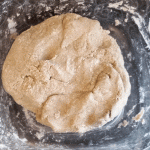
Combine the sponge ingredients and hand-knead until they come together as a firm, only slightly sticky dough. Cover and ferment at room temperature (70°F/21°C) 10-12 hours or overnight. The sponge will have expanded to 1½-2 times its original volume.
Final Dough (Day 2, Morning):
| Ingredient | Grams | Ounces | |
| Sponge | 380 | 13.40 | |
| White rye flour | 195 | 6.90 | |
| Medium rye flour | 155 | 5.50 | |
| AP flour | 65 | 2.30 | |
| Warm (110°F/43°C) water | 400 | 14.10 | |
| Salt | 13 | 0.45 | |
| Instant yeast | 4 | 0.15 | |
| Flour for dusting | as needed | ||
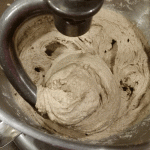 Break the sponge into walnut-sized pieces and combine it in the bowl of a mixer with the final dough ingredients. Use the dough hook at low (KA2) speed and mix until the dough is evenly developed, 6-8 minutes. Cover the bowl and ferment at room temperature until slightly expanded, 20-25 minutes.
Break the sponge into walnut-sized pieces and combine it in the bowl of a mixer with the final dough ingredients. Use the dough hook at low (KA2) speed and mix until the dough is evenly developed, 6-8 minutes. Cover the bowl and ferment at room temperature until slightly expanded, 20-25 minutes.
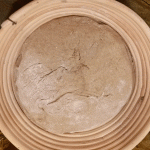 Turn the dough, which will be sticky and soft, onto a well-floured work surface and use floured hands to shape it into a boule or oblong, dust generously with rye flour, and place into a floured bread form or cloth-lined proofing basket.
Turn the dough, which will be sticky and soft, onto a well-floured work surface and use floured hands to shape it into a boule or oblong, dust generously with rye flour, and place into a floured bread form or cloth-lined proofing basket.
Cover and proof at room temperature until the surface of the dough starts to show cracks or broken bubbles and has nearly doubled in volume, 45-50 minutes.
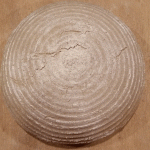 Preheat the oven to 485°F/250°C with the baking surface in the middle and a steam pan on a lower shelf. Turn the loaf onto the baking stone and bake with steam for 10 minutes , then remove the steam pan, reduce the temperature to 420°F/215°C and bake until the loaf thumps when tapped with a finger and the internal temperature is at least 198°F/92°C, 45-50 minutes. Transfer to a rack and cool thoroughly before slicing.
Preheat the oven to 485°F/250°C with the baking surface in the middle and a steam pan on a lower shelf. Turn the loaf onto the baking stone and bake with steam for 10 minutes , then remove the steam pan, reduce the temperature to 420°F/215°C and bake until the loaf thumps when tapped with a finger and the internal temperature is at least 198°F/92°C, 45-50 minutes. Transfer to a rack and cool thoroughly before slicing.
Baker’s Percentages:
| Ingredient |
g |
% |
| TOTAL FLOUR |
650 |
100.00% |
| Medium rye flour |
390 |
60.00% |
| White rye flour |
195 |
30.00% |
| AP flour |
65 |
10.00% |
| Water |
535 |
82.31% |
| Salt |
13 |
2.00% |
| Instant yeast |
4 |
0.62% |
| Rye sour culture |
10 |
1.53% |
| TOTAL FORMULA |
1,212 |
186.46% |

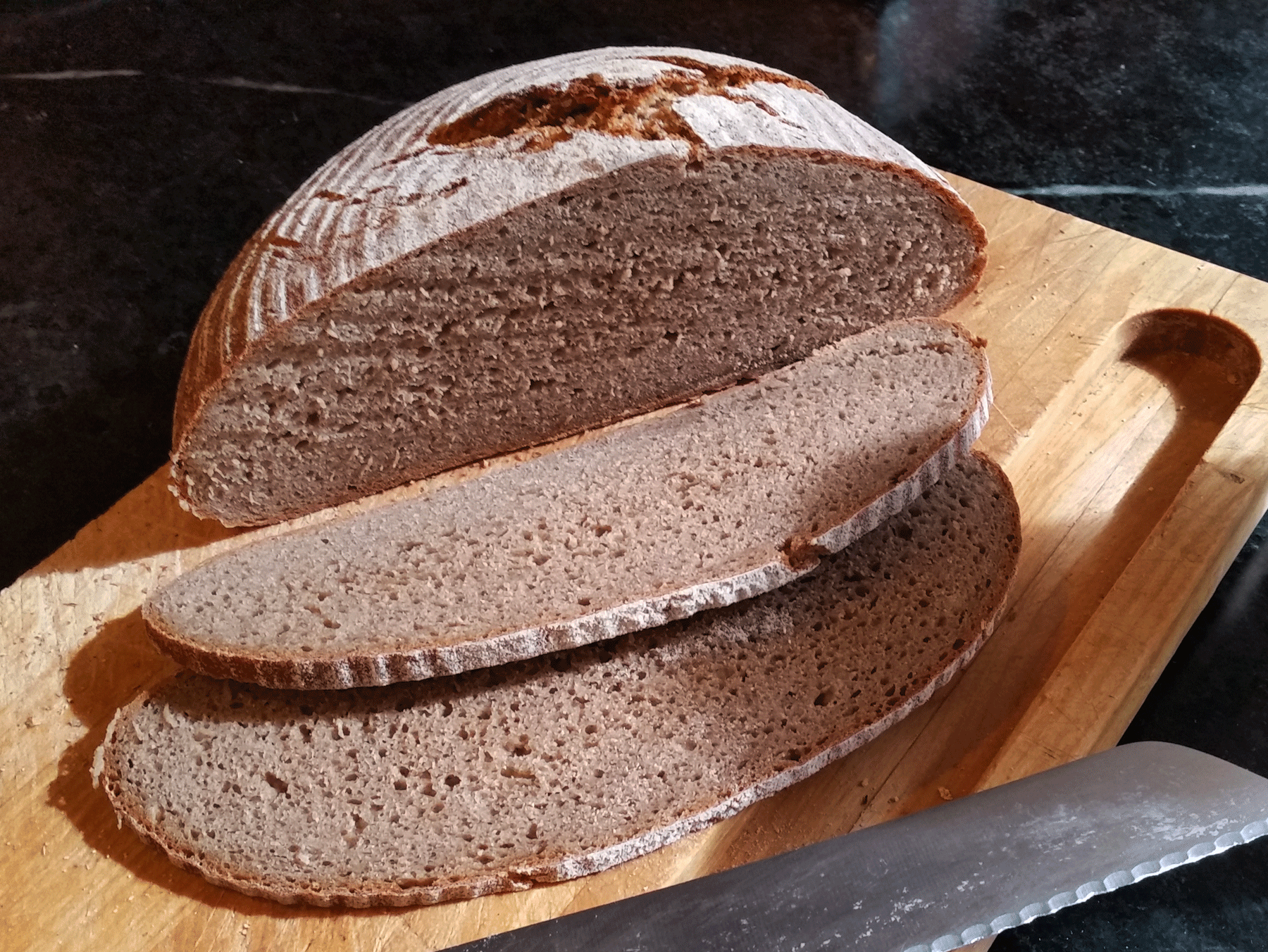
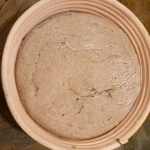

Karin Anderson
January 23, 2016Beautiful loaf! I get withdrawal symptoms, too, when I can’t bake for a longer time…
A few years ago I tested your medium rye in a side by side test with Typ 1150 rye flour (Aurora brand) I had brought from Germany . The bread made with NYBakers medium rye tasted better! (http://www.thefreshloaf.com/node/25482/who-winner-medium-rye-comparison)
I normally use medium rye for both German types. I don’t think there is too much difference in taste, though the color, of course, is darker with 1370/medium rye.
Michiel
January 23, 2016Very recognisable. I traveled in Asia for three weeks, not only without baking but als without proper bread to eat. I almost came to the point to offer the hotelmanagement to bake some bread for them.
Now working on the pumpernickel recipes from the very nice book of Charles Scheele, Old World Bread. He is Dutch from origin, had a bakery in Belgium and moved to the US. You find the book on Amazon.
Jill
January 24, 2016SO happy to see your new blog, and will be watching for The Rye Baker in September!
As a fellow WordPress user, I have used the Follow Widget. Go to the left side of the page as you are in edit or authoring mode, and click on Appearance. The menu underneath will show numerous options, you want to click on Widgets. That brings up a plethora of categories, including “Follow”. Decide where you want to put this button on your blog page, and drag it over to the right side of the page, showing Right Sidebar. Now it will display on your page, and if it’s too high or too low, just adjust accordingly by dragging it up or down in the Right Sidebar window. Good luck!
Stanley Ginsberg
January 25, 2016Thanks, Jill. I just installed jetpack for the same purpose …. and I also subscribed to your blog. Looking forward to lots of interesting posts!
Matt
January 25, 2016How are you defining medium rye? Whole grain? Bran removed? Thanks
Stanley Ginsberg
January 25, 2016If whole rye contains about 1.7% ash, medium rye’s ash content is in the neighborhood of 1.35-1.40% and are equivalent to German Type 1370 rye flour. The medium ryes at my business, The New York Bakers (www.nybakers.com) conform to that standard.
Jill
January 25, 2016Stanley, I made the Berliner today, and it is now my new favorite! SO delicious and easy! I am in heaven. Perfect to eat with goat cheese 🙂 Thanks so much.
Stanley Ginsberg
January 25, 2016That makes me feel really good!!!
Paul
February 1, 2016Hi Stan,
Just made a couple of these and darn you, now I have to keep making them!! Wonderful flavour, great moist crumb, perfect crust. And pretty darn simple to make with just one in-basket proof.
If anyone thinks that because it does go on for two days that this is difficult or time consuming, don’t! The hands-on time is really minimal and the results are decidedly worth it.
Took a snap here: http://bit.ly/TastyBerlinRye
David Snyder
February 2, 2016Hi, Stan.
I must join the Berliner Landbrot fan club! I baked a loaf yesterday and sliced it for lunch today. It is delicious! Your description of the eating quality is spot on. The only note I would add is the very assertive rye flavor, which contrasts with the amazingly light mouth-feel of the crumb.
You can see mine here: http://www.thefreshloaf.com/node/44815/week-date-pain-au-levain-berliner-landbrot
Happy baking!
David
Paul
February 2, 2016Hey David,
That’s a lovely loaf you baked up. Glad the Mrs liked it! Only problem I can see is that now you have to share it. 😉
Your Hamelman loaf looks awesome too. Haven’t tackled that particular loaf in eons, I should revisit this one.
Sharon Wakeford
February 26, 2016Could you tell me if I could use 1050 flour, instead of AP? We don’t really have that in the UK…alternative being something like Canadian Wheat white bread flour. Your help and advice would be very thankfully received.
Stanley Ginsberg
February 26, 20161050 would work well, although it’s a bit strong; 812 would probably work better, but either will be fine.
Sharon Wakeford
February 26, 2016Thank you for taking the time to answer. I am in Germany next week, so can source the flour 😀
Sharon Wakeford
March 9, 2016Hi, I made the bread, which is cooling/settling now. Apparently, 812 is not available outside the trade., so I used 1050. I might have mucked it up though…I added a teaspoon of bread spice to the mix, then read somewhere that Northern German breads generally don’t use this. I still sort of have high hopes, haha. What a doddle to make. Thanks in anticipation of a tasty bread.
Sharon Wakeford
September 15, 2016Revisited this bread again. Made it on Sunday. What a fabulous bread! Today (Thursday), it is still wonderful. My partner is German…I don’t have the loaf anymore – he has taken it home with him! Thank you so much for this recipe.
Felix
October 22, 2016I just moved from Berlin to California and I miss the bread so much (even though it has become harder to get good bread in Berlin, too!)
After making a whole wheat sourdough last weekend that turned out great, I will definitely try to make this Berliner Landbrot this weekend! Big fan of rye breads!
John
December 30, 2016Just found your site and I plan to make your Berliner Landbrot soon. I just made two loaves of my own Sourdough Rye, so I have to wait to make some more. I have been using Bob’s Red Mill whole grain Rye flour, I get it 20lbs at a time. Do you happen to know how that might compare to the type 1150? Also, I’m curious when you say rye sour I assume you mean you feed your yeast with rye flour and not a regular white wheat flour? Thanks
Stanley Ginsberg
January 1, 2017hi John and happy new year. The Germans classify their flours by ash content: wholegrain flour like the Bob’s Red Mill you’re using is called Type 1740 in Germany and contains 1.60-1.80% ash; Type 1150 contains 1.1-1.3% ash, so it’s a much lighter flour than the wholegrain. You can find a couple of charts giving the full rundown of European and US flours, both wheat and rye, on pages 28-29 of The Rye Baker.
As for my rye sour, yes, it’s a sourdough culture that I feed with rye rather than wheat flour. Frankly, the nutrient doesn’t matter much, since its sole purpose is to feed the microorganisms in the culture: the actual amount of seed culture I use to inoculate my sponges rarely exceeds 10-15% of the sponge flour weight, which translates into less than 5% of total flour weight in most cases. That said, I use the same sourdough culture for all my breads, regardless of whether they’re wheat- or rye-based.
Vicki
April 28, 2017Just stumbled upon your website. I am trying to learn how to make rye bread, so far 2 attempts – both failures. This recipe will be my 3rd attempt. I have 1-2 questions I hope you can answer for me. First, while I like rye bread, I am not a huge fan of the overly chewy crust, or the shape (hard to manage portion control). Can I bake this bread in a normal loaf tin? And would that also change the crust texture?
Stanley Ginsberg
May 5, 2017hi Vicki,
Any of the breads can be baked in loaf pans. Baking times shouldn’t change significantly, nor is the crust likely to change much. I would suggest, however, that you check internal temperature towards the end of the bake, since oven temperatures can vary significantly. I like to shoot for a final internal temperature of 195-200F.
Pingback: Recipes From the Rye Baker | Root Simple
Rye Cooder
March 9, 2020Hi Stanley, I made this Berliner Landbrot yesterday, and while it is delicious, it spread all the way out to 10″ on the baking sheet after proofing in the brotform and while baking, with no height. I followed all of the instructions precisely; the only “non-change” being that I had 1150 light rye from New York Bakers, so I didn’t need to use white/medium. What should I do differently? Is the hydration in the formula too much? Should this bread be baked in a dutch oven or clay baker that can keep it contained?
Stanley Ginsberg
May 6, 2020conditions vary. try reducing the hydration.